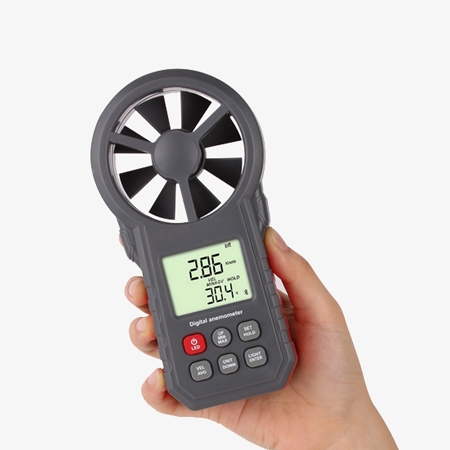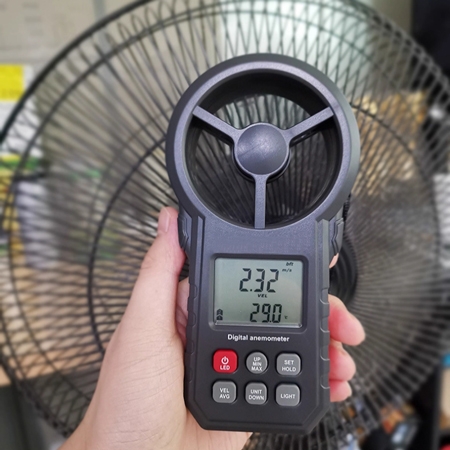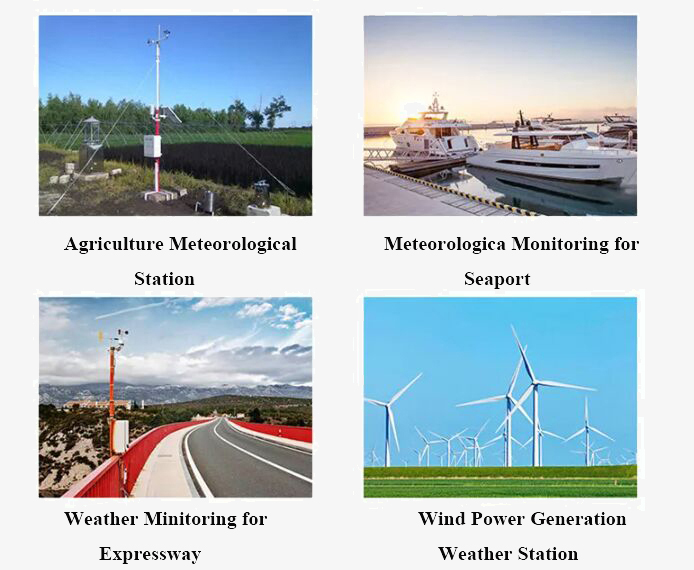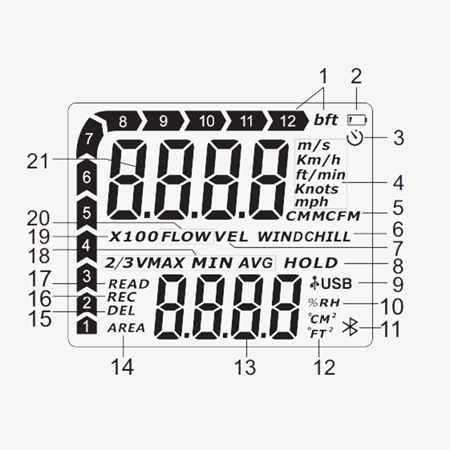The vane anemometer is a comprehensive, easy-to-use, and intelligent measurement tool suitable for a variety of environments and applications, meeting users' diverse wind speed and temperature measurement needs.

Core Measurement and Data Management
- It supports real-time wind speed, average wind speed, maximum wind speed, and minimum wind speed. It also measures temperature and displays the Beaufort scale. Wind speed units support multiple switching options, and temperature units support switching between Celsius (°C) and Fahrenheit (°F).
- It measures air volume, supports switching between CMM (cubic meters per minute) and CFM (cubic feet per minute), and allows area parameters to be set. It also provides a wind chill indicator to help users assess outdoor comfort.
- It records wind speed data with a configurable recording interval and a data hold function, allowing users to lock the current value during measurement. Recorded data can be viewed, deleted, or exported at any time.

Convenient and Practical Data Recording and Transmission
- It connects to an Android phone app (iOS not currently supported) via Bluetooth for real-time data viewing, recording, and configuration. It also supports USB connection to a computer for data analysis and management using dedicated software, and data can be exported to Excel.
- It features an LED light for convenient use at night or in dimly lit environments. It supports an automatic power-off function (after 10 minutes of inactivity) and can be manually turned on or off. The buzzer function can also be set to on or off.
- Powered by a 9V battery, the device is compact and easy to carry and operate.
Application
The three-cup anemometer is widely used for data acquisition in boilers, refrigeration, HVAC, ventilation ducts, agriculture meteorological station, meteorologica monitoring for seaport, weather minitoring for expressway, wind power generation weather station.

| Model | SISCO-BA-WT87B | ||
| Wind Velocity Measurement | |||
| Unit | Range | Resolution | Accuracy |
| m/s | 0~30 | 0.01 | ±5% ±0.1 |
| ft/min | 0~5860 | 1.968 | ±5% ±20 |
| knots | 0~55 | 0.019 | ±5% ±0.2 |
| km/h | 0~90 | 0.036 | ±5% ±0.4 |
| mph | 0~65 | 0.022 | ±5% ±0.2 |
| Wind Temperature Measurement | |||
| Unit | Range | Resolution | Accuracy |
| ℃ | -10℃~+45℃ | 0.1 | ±2℃ |
| ℉ | 14℉~113℉ | 0.2 | 3.6°F |
| Battery | 9V battery (6F22) | ||
| Temperature Sensor | Negative Temperature Coefficient Resistance | ||
| Operation Temperature | -10℃~+45℃(14°F~113°F) | ||
| Operation Humidity | Less than 90%RH | ||
| Storage Temperature | -10℃~+50℃(14°F~122°F) | ||
| Current Consumption | About 6mA/ with Bluetooth on: 16mA | ||
| Weight | 186g(including battery) | ||
| Size | 165mmx85mmx39mm | ||
Structure Diagram

- Beaufort Wind Scale
- LCD Display
- Up/Maximum/Minimum Mode
- Power/Backlight
- Average Wind Speed Measurement
- Switch of Wind Speed Units/Down
- LED Lighting/Confirmation
- Data Holding/Setting

- Beaufort Wind Scale
- Low Battery Indicator
- Timing Automatic Shutdown Indicator
- Wind Speed Unit
- Air Volume Unit
- Wind Cold Indicator
- Wind Speed IconData Holding
- USB
- Humidity Unit
- Bluetooth Icon
- Temperature Unit & Area Unit
- Temperature Display Area
- Area Value
- Delete Records
- Start Recording
- Read Records of Instrument
- Two-thirds of Maximum Wind Speed/Maximum/Minimum/Average Wind Speed
- X10 times,×100 times (×10 appears when the value exceeds 99.99,×100 appears when the value exceeds 999.99)
- Air Volume Icon
- Display Area of Wind Speed
Q1: How do you ensure accuracy of anemometer?
A1: To make sure anemometers are reliable and precise, they should be regularly calibrated. This is the procedure of checking the accuracy of a measuring instrument – as well as the adjustment to align it with the standard. The process allows equipment to produce more accurate results than would've otherwise been possible.
Q2: What affects an anemometer?
A2: The higher the wind speed, the more power is required to keep the wire at a constant temperature. Wind speed can also be determined by measuring air pressure. (Air pressure itself is measured by an instrument called a barometer.) A tube anemometer uses air pressure to determine the wind pressure, or speed.
Q3: Does an anemometer measure wind direction?
A3: An anemometer looks like a weather vane, but instead of measuring which direction the wind is blowing with pointers, it has four cups so that it can more accurately measure wind speed. Each cup is attached to the end of a horizontal arm, each of which is mounted on a central axis, like spokes on a wheel.
Tips: What is The Difference Between an Anemometer and an Air Flow meter?
The key difference between anemometers and air flow meters lies in their measurement targets and application scenarios. Anemometers primarily measure air velocity per unit time (common units are m/s, km/h, etc.), focusing on wind speed, such as outdoor wind speed or airflow velocity at air conditioner outlets. Their core function is to capture the velocity of airflow. Air flow meters, on the other hand, measure the volume of air passing through a specific cross-section per unit time (common units are m³/h, L/s, etc.), focusing on total wind volume, such as calculating air flow through ventilation ducts or ventilation systems. The two are related, and the choice depends on actual needs: if you're interested in speed, choose an anemometer; if you're interested in volume flow, choose an air flow meter.
Thank you for buying industrial test and measurement equipment on SISCO.com, all products sold by SISCO and the partner cover a 12 months warranty, effective from the date of receiving the products.
What is covered?
SISCO is responsible for providing free spare parts, and free technical support to assist the customer to repair the defective products until the problem is solved.
What is not covered?
- Product purchased from anyone other than a SISCO store or a SISCO authorized reseller.
- Expendable parts.
- Routine cleaning or normal cosmetic and mechanical wear.
- Damage from misuse, abuse or neglect.
- Damage from use of parts other than SISCO approved.
- Damage from use outside the product’s usage or storage parameters.
- Damage from use of parts not sold by SISCO.
- Damage from modification or incorporation into other products.
- Damage from repair or replacement of warranted parts by a service provider other than a SISCO authorized service provider.
- Damage caused by the application environment not meeting the product usage requirements and the failure to perform preventive maintenance.

